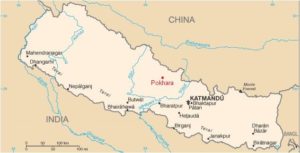Nos projets
NOS PROJETS EN COURS
Nepal :
Prevention and protection of children from the risks of sexual exploitation in the adult tourism and entertainment sector
Location
Pokhara, Kaski district in central Nepal

Duration
October 2017 – December 2019
Context
Pokhara, located in the foothills of Annapurna, is a famous tourist centre that attracts a large number of international and national tourists for its views of the mountains and natural lakes. Pokhara is also an economic hub for migrants from western Nepal, many of whom arrive at work in the tourism and hotel sector. It is noted that this migration to Pokhara has increased from the districts affected by the devastating earthquake of 2015, particularly the neighbouring district of Gorkha, where the epicentre of the devastating earthquake was located (see second photo). Pokhara is therefore a strategic point of intervention because of its proximity to all the districts affected by the earthquake. Unfortunately, trafficking in human beings in Pokhara was reported to have increased after the earthquake. People at risk of trafficking are also children and adolescents who have been attracted to the city by the various agents and sources who have made them promises of work and other economic opportunities.
In its latest report on trafficking in human beings, the National Human Rights Commission of Nepal reports that all police stations in the earthquake-affected districts (14) reported that the number of missing children has increased by 40 per cent compared to the average number of missing children in the last three years just before the earthquake. [1]
The “adult entertainment” sector in Pokhara is dynamic and growing, for tourists from Nepal more and more, but also from India and elsewhere. Child protection actors and researchers working in Pokhara report that small hotels, guest houses and dance bars in and around bus and truck fleets or tourist areas such as the lake region have become hubs for the sex trade.
Project Objective
Protecting vulnerable children from sexual exploitation in the tourism and adult entertainment sector
Expected Results
- Sexual exploitation and trafficking for sexual purposes of vulnerable children are prevented
- Children are removed from vulnerable and protected conditions
- The capacity of local actors to effectively combat the sexual exploitation of children is strengthened
- Knowledge and data on good practices are generated and shared
- The capacity of child protection actors is strengthened to prevent sexual exploitation and ensure the protection of child victims.
Target Groups
- Children and young girls working in the adult entertainment, their families and communities
- Child protection actors, including organizations working in prevention
- Business owners in the adult entertainment sector
Direct Beneficiaries
- 280 vulnerable children and young girls have direct access to support
- 30 vulnerable children and young girls receive vocational training
- 25 vulnerable children and young girls are supported to develop an income-generating activity
- 60 vulnerable children receive support for schooling.
- 17,000 people sensitized on the risks of trafficking and vulnerabilities in the tourism sector
- 3000 children sensitized on the risks of trafficking and vulnerabilities in the tourism sector
- 1200 children and community members
Budget
115,000 Euros
Local Partner
Shakti Samuha, an association founded by survivors of trafficking for sexual purposes.
https://www.facebook.com/Shakti-Samuha-201460053222376/
Institutional Partner
Ministère des Affaires Étrangères et Européennes du Luxembourg
Facts
Incidence of child labour (2009-2015): 37%[2]
Incidence of girls in child labour (2009-2015): 38%[3]
Estimated number of victims of trafficking in 2015 and 2016: 6100[4]
Estimated number of attempted trafficking cases: 13,600, 98% female and 50% child[5]
Estimated number of missing children in 2015 and 2016: 1502, 60% of whom were girls[6].
[1] National Human Rights Commission, Office of the Special Rapporteur on Trafficking in Women and Children, Nepal, “Trafficking in Persons National Report 2015-2016”, June 2017
[2] UNICEF, State of the World’s Children, 2016, p151
[3] Ib.
[4] National Human Rights Council, Trafficking in Persons, National Report 2015-2015, Nepal, June 2017, page 13
[5] National Human Rights Council, Trafficking in Persons, National Report 2015-2015, Nepal, June 2017, page 14
[6] National Human Rights Council, Trafficking in Persons, National Report 2015-2015, Nepal, June 2017, page 16
.

